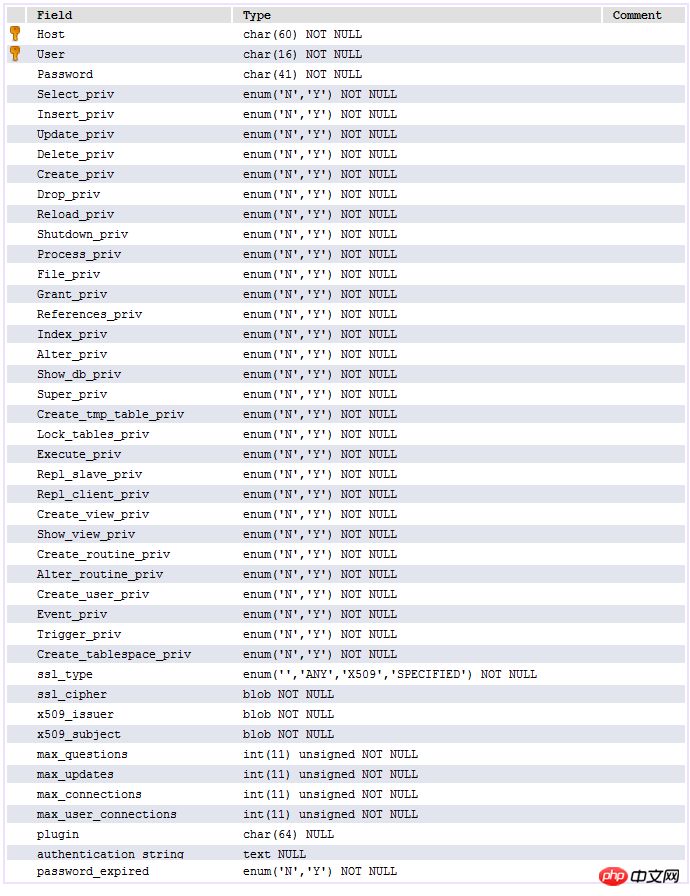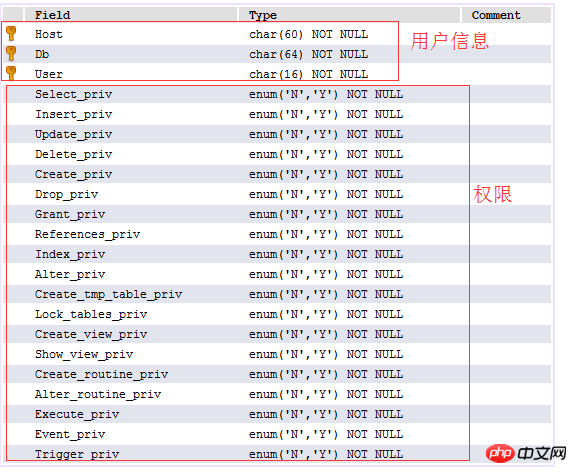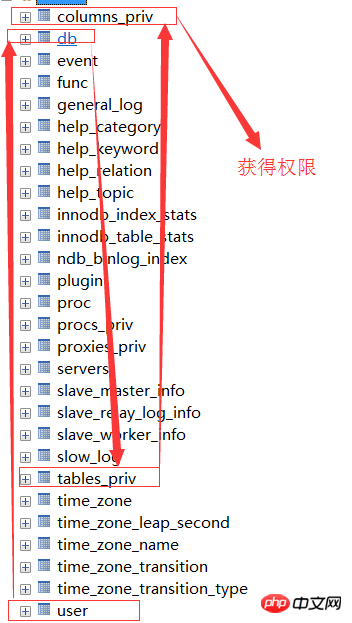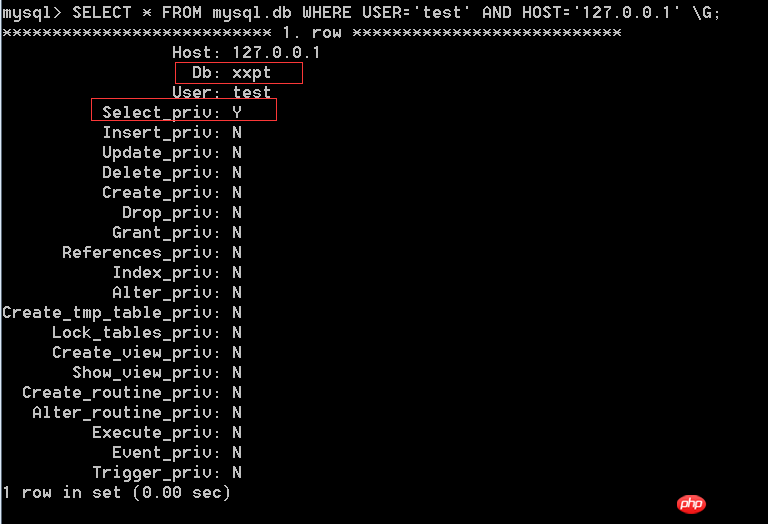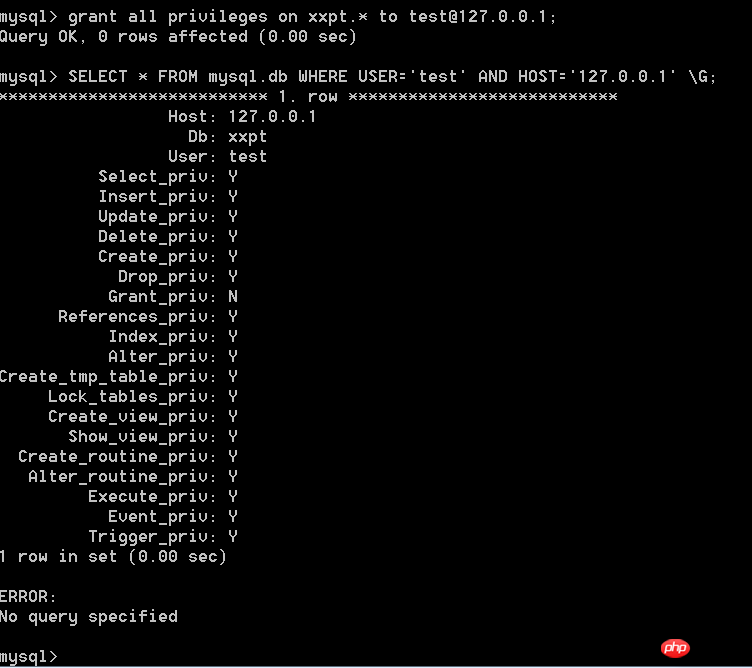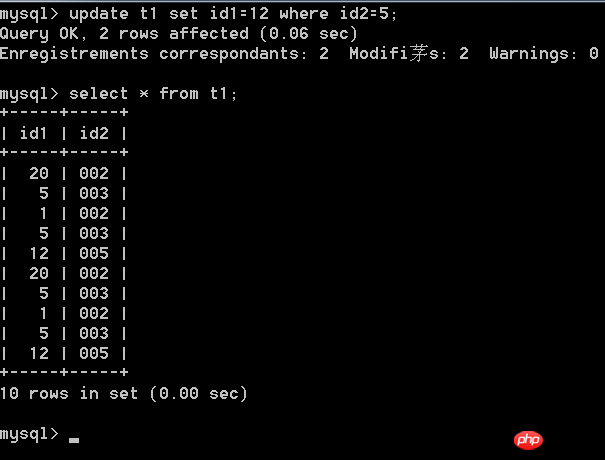Detailed introduction to permission management in MySQL
Permission Management
The MySQL permission system authenticates through the following two stages:
Perform identity authentication on connected users. Legal users pass the authentication, and illegal users refuse to connect.
Grant corresponding permissions to legal users who have passed the authentication. Users can perform corresponding operations on the database within the scope of these permissions.
In the permission access process, it mainly involves the user table and db table under the mysql database. The data structure of the user table is as follows:
The data structure of the db table is as follows:
Description of the table: It contains user columns, permission columns, security columns and resource control columns. The most frequently used ones are the user column and the permission column. Permissions are divided into normal permissions and management permissions. Operations of ordinary permissions user database such as select_priv, insert_priv, etc. Management permissions are mainly used to manage database operations, such as process_priv, super_priv, etc.
When a user connects, the access process of the permission table:First determine the connected IP and user from the three fields of host, user and password in the user table Whether the name and password exist in the table, if they exist, the verification is passed, otherwise the connection is refused.
After passing the authentication, obtain the database permissions in the order of the following permission table: user->db->tables->priv->columns_priv. Global permissions cover local permissions. For example, if a user has select permission in the user table, then he will have select permission on all columns in all tables in all data.

Detailed description of permission search: When the user passes permission authentication, when allocating permissions, the permissions are allocated in the order of user->db->tables_priv->columns_priv, that is, the permissions are checked first. Table user, if the corresponding permission in the user table is Y, then all database permissions corresponding to the user are Y, and db, tables_priv, and columns_priv will no longer be checked; if it is N, the user's specific database permissions will be searched in the db table. , if you get the Y permission in the db, you will not be searching. Otherwise, you will check tables_priv to see the specific table permissions corresponding to the database. If it is Y, you will not be searching. Otherwise, you will be checking the columns_priv table to see the corresponding specific column permissions. This is important when we grant user permissions.
Account management
Create user
To create a user, you can use grant syntax to create or directly operate the user table.
Method 1:
Directly operate the use table
insert into user(Host,User,Password) values(“127.0.0.1 ","test",password("51testit"));
Method 2:
Format CREATE USER 'username'@'host' IDENTIFIED BY 'password';
eg:CREATE USER 'test'@ '127.0.0.1' IDENTIFIED BY '51testit'; 
After creation, log in as follows: 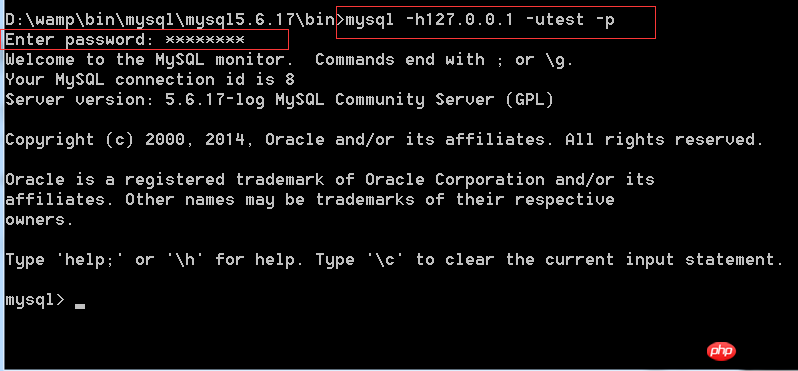
MySQL encryption method: MYSQL323 encryption generates a 16-bit string. What survives in MySQLSHA1 is a 41-bit string, of which is not added to the actual password operation. Through observation, many users carry "", and the "*" is removed during the actual cracking process. In other words, the actual number of digits in the password encrypted by MySQLSHA1 is 40 digits.
Host field description
The Host value can be the host name or IP number, or locahost represents the local host.
You can use wildcard characters "%" and "_" in front of the host column value. "%" means matching any host. An empty Host value is equal to "%". For example, "%.myweb.com" matches all hosts in all mysql.com domains. The case is as follows:
| Host | User | Analysis |
|---|---|---|
| myweb.wang | pps | pps, connect from myweb.wang |
| pps | pps, connect from any host | |
| ” | Any user, connect from any host | |
| pps | pps, connect from 122.164.35.127 | |
| pps | pps, connect from any host on 122.164.35. type subnet |
##Permissions |
Permission Level |
Permission Description |
| CREATE | Database, table or index | Create database , table or index permission |
| ##Database or table | Delete database or table permissions | |
##Database, table or saved program |
Grant permission options |
REFERENCES |
Database or table |
|
ALTER |
| ##Table | Change the table, such as adding fields, indexes, etc. | DELETE |
| Table | Delete data permission | INDEX |
| Index permission | INSERT |
|
| Insert permission | SELECT |
|
| Query Permission |
|
UPDATE |
Update Permissions |
||
CREATE VIEW |
View | Create View Permission |
SHOW VIEW |
View |
View View Permission |
ALTER ROUTINE |
Stored Procedure |
Change stored procedure permissions |
CREATE ROUTINE |
Stored procedure |
Create Stored Procedure Permission |
EXECUTE |
Stored Procedure |
Permission to execute stored procedures |
| ##FILE | ##File access on the server hostFile Access Permissions | |
| Server Management | Create temporary table permissions | |
| Server management | Lock table permission | ##CREATE USER |
Server management |
Create User Permissions |
PROCESS |
Server Management |
View process permissions |
##RELOAD |
| ##Server management |
Permission to execute flush-hosts, flush-logs, flush-privileges, flush-status, flush-tables, flush-threads, refresh, reload and other commands
|
REPLICATION CLIENT |
| Replication Permissions | REPLICATION SLAVE |
|
| Replication Permission | SHOW DATABASES |
|
| View database permissions | SHUTDOWN |
|
| Close database permissions | SUPER |
|
| Execute kill thread permission |
| How MYSQL permissions are distributed, that is, what permissions can be set for tables, what permissions can be set for columns, etc. This can be explained from a table in the official documentation:
Permission distribution
Table permissions |
|
Column permissions |
|
Process Permissions |
|
|
|

Hot AI Tools

Undresser.AI Undress
AI-powered app for creating realistic nude photos

AI Clothes Remover
Online AI tool for removing clothes from photos.

Undress AI Tool
Undress images for free

Clothoff.io
AI clothes remover

AI Hentai Generator
Generate AI Hentai for free.

Hot Article

Hot Tools

Notepad++7.3.1
Easy-to-use and free code editor

SublimeText3 Chinese version
Chinese version, very easy to use

Zend Studio 13.0.1
Powerful PHP integrated development environment

Dreamweaver CS6
Visual web development tools

SublimeText3 Mac version
God-level code editing software (SublimeText3)

Hot Topics
 1378
1378
 52
52
 MySQL: The Ease of Data Management for Beginners
Apr 09, 2025 am 12:07 AM
MySQL: The Ease of Data Management for Beginners
Apr 09, 2025 am 12:07 AM
MySQL is suitable for beginners because it is simple to install, powerful and easy to manage data. 1. Simple installation and configuration, suitable for a variety of operating systems. 2. Support basic operations such as creating databases and tables, inserting, querying, updating and deleting data. 3. Provide advanced functions such as JOIN operations and subqueries. 4. Performance can be improved through indexing, query optimization and table partitioning. 5. Support backup, recovery and security measures to ensure data security and consistency.
 How to open phpmyadmin
Apr 10, 2025 pm 10:51 PM
How to open phpmyadmin
Apr 10, 2025 pm 10:51 PM
You can open phpMyAdmin through the following steps: 1. Log in to the website control panel; 2. Find and click the phpMyAdmin icon; 3. Enter MySQL credentials; 4. Click "Login".
 MySQL: Simple Concepts for Easy Learning
Apr 10, 2025 am 09:29 AM
MySQL: Simple Concepts for Easy Learning
Apr 10, 2025 am 09:29 AM
MySQL is an open source relational database management system. 1) Create database and tables: Use the CREATEDATABASE and CREATETABLE commands. 2) Basic operations: INSERT, UPDATE, DELETE and SELECT. 3) Advanced operations: JOIN, subquery and transaction processing. 4) Debugging skills: Check syntax, data type and permissions. 5) Optimization suggestions: Use indexes, avoid SELECT* and use transactions.
 How to create navicat premium
Apr 09, 2025 am 07:09 AM
How to create navicat premium
Apr 09, 2025 am 07:09 AM
Create a database using Navicat Premium: Connect to the database server and enter the connection parameters. Right-click on the server and select Create Database. Enter the name of the new database and the specified character set and collation. Connect to the new database and create the table in the Object Browser. Right-click on the table and select Insert Data to insert the data.
 MySQL and SQL: Essential Skills for Developers
Apr 10, 2025 am 09:30 AM
MySQL and SQL: Essential Skills for Developers
Apr 10, 2025 am 09:30 AM
MySQL and SQL are essential skills for developers. 1.MySQL is an open source relational database management system, and SQL is the standard language used to manage and operate databases. 2.MySQL supports multiple storage engines through efficient data storage and retrieval functions, and SQL completes complex data operations through simple statements. 3. Examples of usage include basic queries and advanced queries, such as filtering and sorting by condition. 4. Common errors include syntax errors and performance issues, which can be optimized by checking SQL statements and using EXPLAIN commands. 5. Performance optimization techniques include using indexes, avoiding full table scanning, optimizing JOIN operations and improving code readability.
 How to create a new connection to mysql in navicat
Apr 09, 2025 am 07:21 AM
How to create a new connection to mysql in navicat
Apr 09, 2025 am 07:21 AM
You can create a new MySQL connection in Navicat by following the steps: Open the application and select New Connection (Ctrl N). Select "MySQL" as the connection type. Enter the hostname/IP address, port, username, and password. (Optional) Configure advanced options. Save the connection and enter the connection name.
 How to recover data after SQL deletes rows
Apr 09, 2025 pm 12:21 PM
How to recover data after SQL deletes rows
Apr 09, 2025 pm 12:21 PM
Recovering deleted rows directly from the database is usually impossible unless there is a backup or transaction rollback mechanism. Key point: Transaction rollback: Execute ROLLBACK before the transaction is committed to recover data. Backup: Regular backup of the database can be used to quickly restore data. Database snapshot: You can create a read-only copy of the database and restore the data after the data is deleted accidentally. Use DELETE statement with caution: Check the conditions carefully to avoid accidentally deleting data. Use the WHERE clause: explicitly specify the data to be deleted. Use the test environment: Test before performing a DELETE operation.
 How to execute sql in navicat
Apr 08, 2025 pm 11:42 PM
How to execute sql in navicat
Apr 08, 2025 pm 11:42 PM
Steps to perform SQL in Navicat: Connect to the database. Create a SQL Editor window. Write SQL queries or scripts. Click the Run button to execute a query or script. View the results (if the query is executed).




